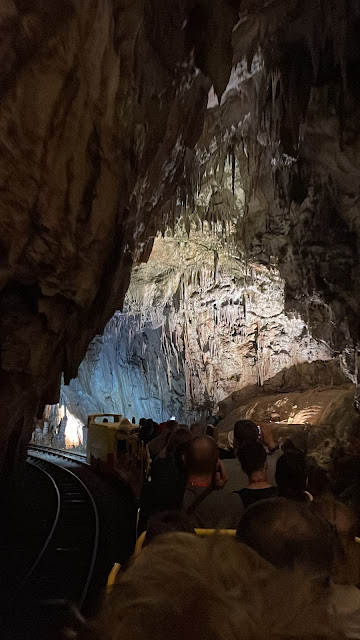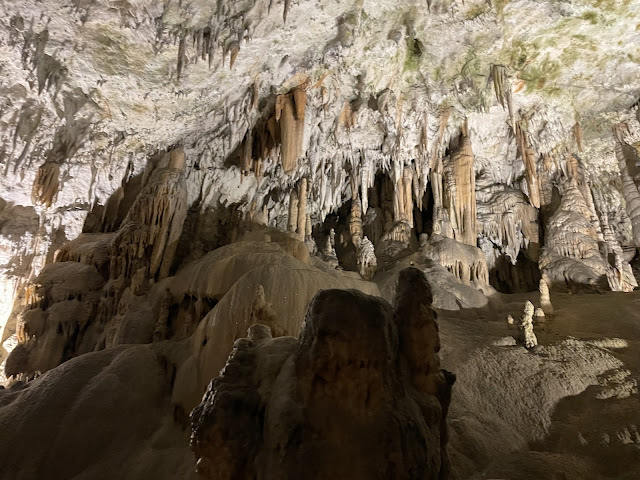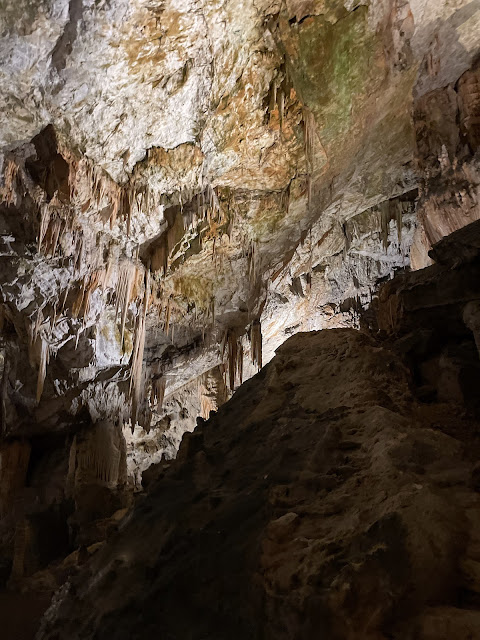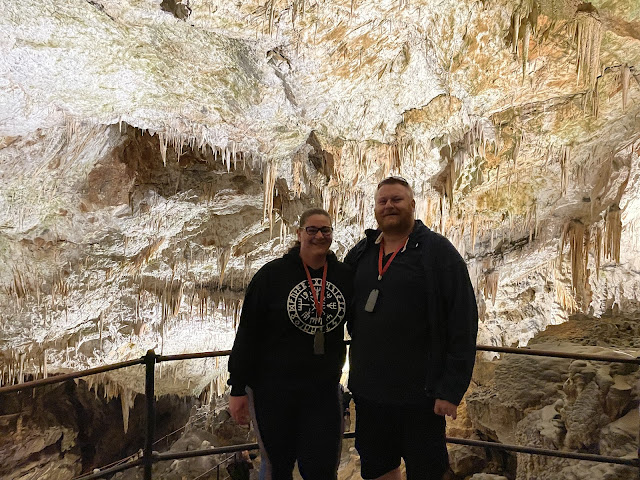Most of the days on our trip I had a list of things and places to see, but we didn't prebook anything except accommodation - we could see the sights and weren't limited by set times. But today we I had prebooked us two excursions in Slovenia.
The first was Postojna Caves (Postojnska jama), pronounced "post-oy-nah". I wasn't sure what to expect from the caves, but it had looked pretty good when I was researching and since I'd booked the tickets it had been recommended by several people.
The cave is a karst cave, meaning that it is formed from dissolving soluble carbonate rocks - dolomite, gypsum and limestone. Postojna is one of a band of karst caves around that area of Slovenia and Croatia, and is probably the most impressive. It stretches for 24.34km, but the tour covers 3.7km, some of it by underground train.
The cave was first reported in the 1600s, but contains graffiti from 1213. In the early 1800s the cave was prepared for tourists and was visited by Francis I, Emperor of Austria-Hungary. During these preparations, the lamp-lighter accidentally discovered an entirely new section of the caves. In 1819 Archduke Ferdinand visited the caves and electric lighting was added in 1884, before the town of Ljubljana even had electric lights. The rails were added in 1872 allowing for tour guides to push the carts of tourists, and a gas train was added in the 1900s. During the first World War, Russian POWs were forced to build a bridge in the cave, known as the Russian Bridge and in WWII the Germans used the cave to store aircraft fuel. Slovene guerrilla forces set fire to the 1,000 barrels of fuel, causing a fire that burned for seven days.
We parked in a large carpark and had a short walk up to the main cave complex, passing over a small river and past a waterwheel:
We'd given ourselves extra time to make sure we didn't miss the start of our tour, so we checked out the souvenir's and the signs around the start of the cave.
I was a little worried as the tour groups were pretty large - our time ended up with around 100 people queued up, but throughout the tour (except for the souvenir shop in the cave at the end) it never really felt crowded.
When our time was called, we filed in, picked up an audio guide and were led through into a train:
Once the train was full, we started our trip into the cave - the caverns were enormous and each time we were impressed by one, we moved onto the next more impressive area:
We got off the train at the bottom of a big mountain inside the cave and after a few photos we started our way up. It was really impressive. The mountain is called the Cavalry and has a volume of more than 168,000 cubic meters - bigger than London's St Paul's Cathedral
This first cavern alone was enough to rival any caves I had seen before, but it was still only the start of the tour. After reaching the top of the hill, we headed down the other side towards the Russian Bridge.
 |
| The Russian Bridge |
We passed over the Russian Bridge and through a cave passage towards the next section:
The audio guide then mentioned we were about to enter the three most beautiful chambers of the caves, the Spaghetti, White and Red halls. What we had seen so far had been breath-taking, so the next part would need to be amazing to top it.
The roof of spaghetti hall was lined with thin stalactites:
Next was White Hall - filled with some of the more pure white stalagmites and stalactites. The colour comes from impurities in the water that filters down:
We moved on to the Red Hall - the colour here is created by impurities, such as iron, in the water:
,
We then passed under the Russian Bridge to the last part of the caves:
The symbol of the Postojna Caves is "Brilliant" two pillars - one white and one red:








We then passed on to the final part of the tour - walking through to the concert hall, where musical concerts had been played, to the world's only cave post office. We sent ourselves a card, which arrived home before we did, with a special postal mark and then boarded the train to head back out.
One of the other things that the caves were famous for is the Olm, or the Proteus. The Olm is an aquatic cave salamander that lives only in caves in this area of the world. Since they live in complete darkness they have no eyes or skin pigmentation. They grow to about 20-20cm long and are the largest cave-dwelling animal in the world. They feed on anything washed into the cave, but can go for up to 10 years without eating. Postojna Cave has a large population of olm, and has been involved in breeding exercised to increase the population. There was an aquarium in the cave with some olm, but we were not allow to take photos due to the olm's light sensitivity. The boys and I were unable to see the olm, but Kristine hung back and managed to catch a glimpse. We would later see them when we visited a cave in Croatia.
We had a quick lunch at the restaurant and then caught a tourist bus to our second destination - the Predjama Cave Castle.
Predjama Castle (Predjamski grad) was first noted in 1274 as being the castle Luegg, built in a cave in Slovenia. It was owned by the Luegg family who were titled as the Knights of Adelsberg (which was the German name for Postojna).
The castle became famous in the 1400s, when Erasmus of Lueg held the seat and operated as a robber baron. Erasmus killed the commander of the Habsburg Imperial Army, Marshal Pappenheim, after Pappenheim insulted the honor of Erasmus' dead friend. The Holy Roman Emperor Frederick III put out a request for his capture, so Erasmus fled to Predjama Castle.
Erasmus allied himself with the King of Hungary, Matthias Corvinus and used his fortified position to attack the Habsburg towns in the area. Eventually the governor of Trieste, Andrej Ravbar killed Erasmus after a siege.
There are several stories of the siege and it is difficult to tell what is legend and what is fact. The castle guides pass off the stories as actual accounts, but there are some doubts. The first is that during the siege, Erasmus used a secret passage (that does exist) to estates outside the castle, where he retrieved food for him and his men. The valley where he obtained the food was warmer and so cherries ripened earlier than the surrounding area. Erasmus threw these cherries down on the besieging forces, who believed he had made a pact with the devil as cherries in their area had not yet ripened and they did not see a way he could have obtained cherries while under siege.
A second story tells that Erasmus was betrayed by a servant, who informed the enemy that Erasmus used the lavatory at a certain time before bed. Due to the design needs, the lavatory had the thinnest walls (it needed to allow the waste to fall outside the castle walls). One night when Erasmus went to the toilet, the servant lit a candle in a window, signaling the forces below. A cannon was fired into the walls of the lavatory, killing Erasmus.
Regardless of how he was killed, Erasmus was eventually defeated and the castle ruins were passed on to the Oberburg family and then the Purgstall family. The Purgstalls built a second castle, which was destroyed by an earthquake in the 1511.
The renaissance version of the castle was built in 1570 and remains unchanged. In the 1700s the castle was used a s a summer residence of the Cobenzi family. It passed hands several times by inheritance before being seized and nationalized by the Yugoslavian government after World War II.
The bus dropped us off at the entrance to the castle and it made an impressive sight. Almost entirely recessed into the cliff, it would be a difficult place to attack. Below the castle were several caves, but our tour was limited to the castle itself.
Unfortunately the castle was very crowded and so we didn't enjoy the visit inside as much as we enjoyed the views from outside.
We entered into the main hallway of the castle and then up the stairs to a few display rooms. One of the most interesting part of the castle was how it blended man-made with natural rock. Since the castle was built for defence, it wasn't terribly comfortable for the occupants and was often drafty and damp.
 |
| Crowds at the entrance |
 |
| View from the window |
 |
| A passage behind the wall |
 |
| Rock wall on the left, merging to man.-made on the right |
 |
| Kitchens |
 |
| Torture room |
 |
| Bedroom |
 |
| Kobenzl Coat of Arms |
 |
| Windischgrätz Coat of Arms |
We then headed into the courtyard area and up a set of steps into some of the higher levels:
 |
| Path up to Erasmus' secret passage |
 |
| These stairs led up the secret passage were inaccessible as they were dangerous to travel |
 |
| Well in the secret passage |
After finishing up at the castle, we took the bus back to Postojna to collect the car and then drove onward into Zagreb, the capital of Croatia. Our accommodation was Apartment Marija, which was comfortable, however there was no hot water available in that part of Zagreb (we'd been warned in advance) for the entire week. Luckily it was only a night and we made do with colder showers.




























































































































No comments:
Post a Comment